Sucking worms in dwarf shrimp in the aquarium
Table of Contents
Recognize sucking worms
Sucking worms that attach to Neocaridina shrimp are sometimes called gill worms. However, they have nothing to do with the dangerous gill worms in fish, but are so named because they can partially sit in the gill chamber of shrimp. Unlike gill worms in fish, shrimp suckworms do not belong to the trematodes, but to the whirl worms. The name sucker worms does not come from the fact that the worms would suck out their "victim", but from the fact that they have a sucker with which they can hold on to the shell of crustaceans.
The genus of these sucker worms that sit on shrimp is called Scutariella, and the worms belong to the class Temnocephalidae, like the so-called Tylomelania flukes or the crayfish flukes on Cherax crustaceans. By the way, the two mentioned worm species are not leeches either, they are just called that.
The common suckworms in aquaristics seem to be specialized on Neocaridina shrimps as host, you don't see these little worms in bee shrimps, tiger shrimps, amano shrimps or other shrimp species in the aquarium.
Scutariella sucker worms grow to about 2mm long and have a sucker at the lower end of their body. At the upper end they run out in a Y-shape - they have two broad tentacles or lobe-like appendages at the head end that are clearly visible with a magnifying glass. Their color is transparent whitish to white.
They are quite easy to distinguish from bell-shaped animals because they are not so fluffy. Bell animals look like a transparent film of fluff, while sucking worms are clearly distinguishable individual rods. Also, bellworms sit nonspecifically on the shrimp's body, on the leg attachments, on the surface of the head carapace, on the antennae, ... while Scutariella prefer very specific body sites on dwarf shrimp.
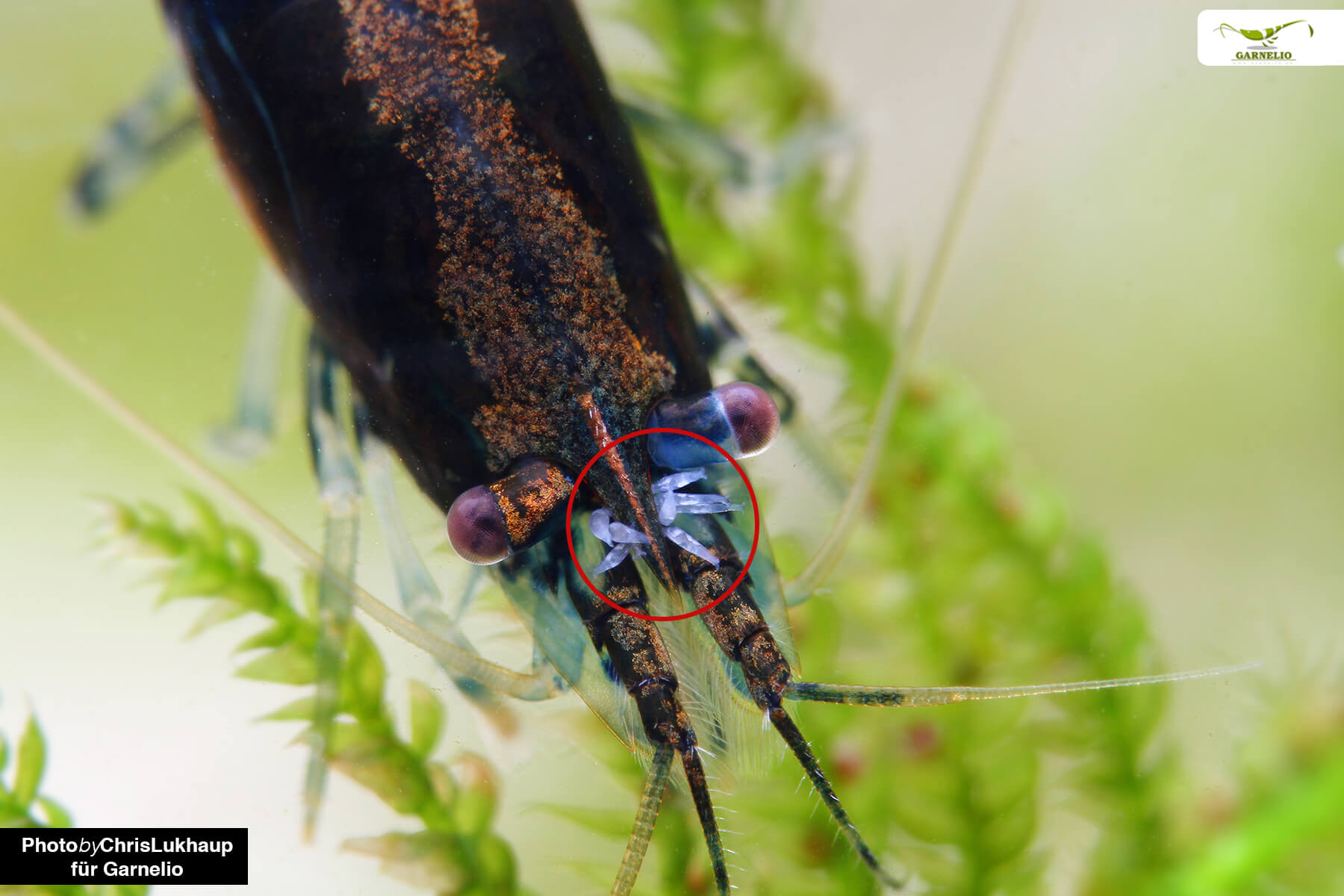
Where are the sucking worms located on shrimp?
Most Scutariella species are harmless sit-on worms that simply use the shrimp as a substrate to sit on.
A heavy infestation of sucker worms can be recognized in shrimp as a whitish "beard" next to or on the rostrum, the forward protruding spine that sits between the shrimp's eyes. Rather rarely, sucker worms also sit between the legs or the webbed feet on the abdomen, but there they are hardly noticeable.
The worms also like to sit in the gill chamber. Here you can recognize a sucking worm infestation in shrimps only in relatively transparent Neocaridina color varieties like Yellow Fire, Blue Jelly, White Pearl and not well colored Red Fire dwarf shrimps. Here the suckers can be seen as whitish dots, also the eggs of the worms can be seen as sharply defined, slightly smaller white dots.
If the shrimp are treated for sucker worms with worming agents such as Panacur or Flubenol, it is possible that the white dots will continue to be seen even though the eggs have died and nothing will develop from them. Possibly the shrimp encapsulate the eggs in the tissue, in any case the dots can still be seen after a moult. However, no new sucker worms develop from them after treatment with these drugs - but the infestation remains visible.
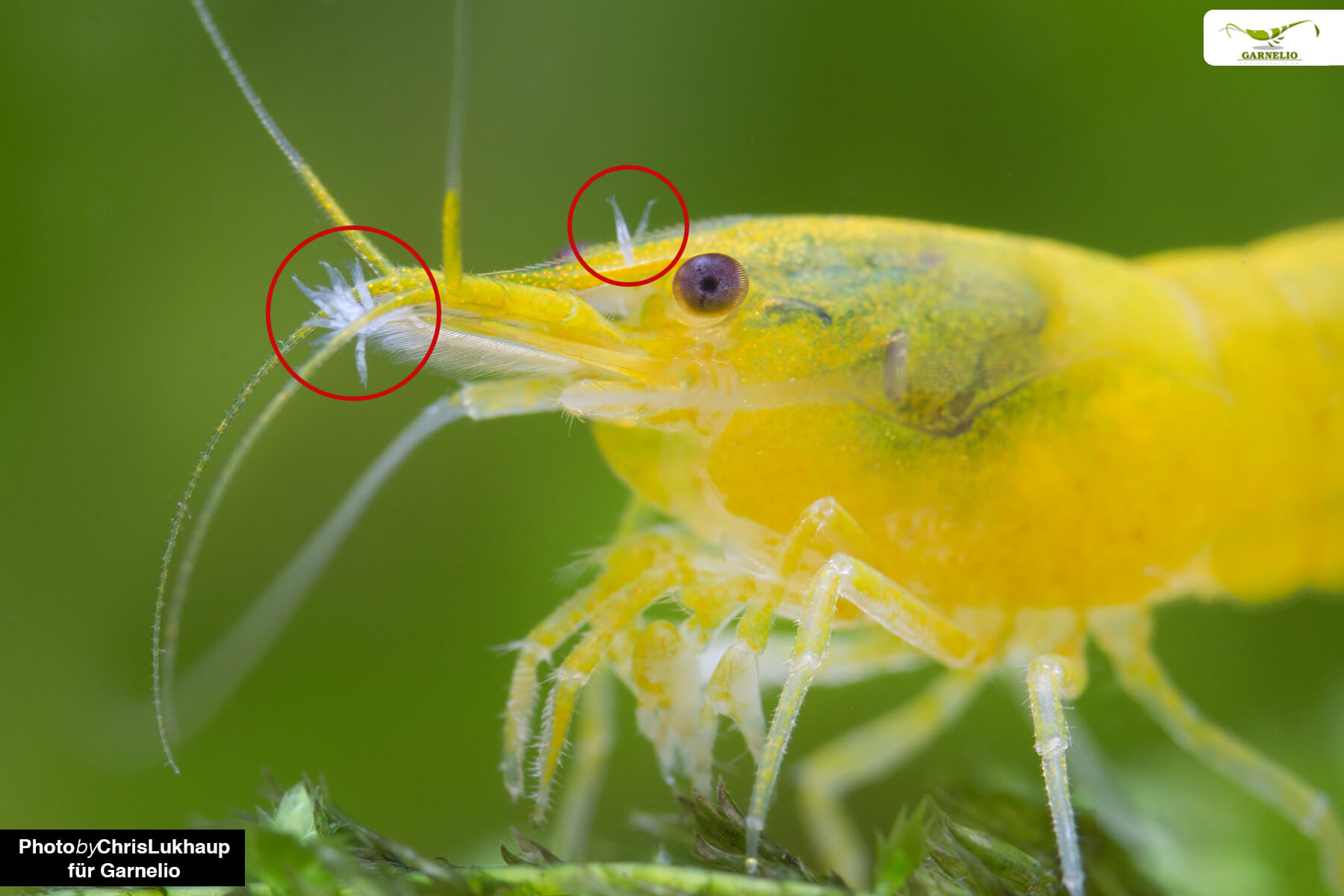
How do suckworms reproduce?
Sucking worms are hermaphrodites, meaning that a single worm has both female and male reproductive organs. After mating, Scutariella lay their egg cocoons on the gill leaflets or on the inside of the carapace of the shrimp's gill cavity. Depending on the temperature, the young worms hatch after about two weeks.
What do sucking worms eat?
Most sucker worms in Neocaridina shrimp in the aquarium are so-called ectosymbionts that simply live on the shrimp - they are commensals, harmless epiphytes. These sucking worm species live on fine suspended particles that are stirred up by the shrimp when they feed. The gill's respiratory water stream contains many of these fine detritus suspended particles, and the sucker worms therefore find a lot of food in the water that the shrimp swirls past their gills.
The rostrum is also a cold buffet spot for the worms. Here they get particularly well to the food particles swirled up by the feeding. Furthermore, like other temnocephalids, Scutariella feed on microorganisms that grow on the shrimp's carapace - they even keep it clean by doing so.
There is no evidence that shrimp may be bothered by sucker worms. They show no behavioral differences compared to dwarf shrimp without sucker worm infestation.
Unfortunately, however, there are studies showing that some species of sucker worms live parasitically and suck blood. So far, however, these seem to be very few species, usually an infestation of sucker worms in shrimp in the aquarium can be classified as rather harmless.
Even the parasitic sucking worms do not directly threaten the life of the shrimp. However, if the shrimp is heavily infested, it may be weakened.
On the other hand, as weakling parasites, suckworms generally gzm1only multiply strongly when the shrimp's defense system is weakened by stress, transport, or disease - so it is not known exactly what is cause and what is consequence. Unfavorable husbandry conditions, one-sided feeding and stress together with a sucker worm infestation can lead to an increased mortality rate. Also, heavily infested animals may reproduce less well.
How do sucking worms move?
Sucker worms hold onto the shrimp's carapace with their suction cup. They wag their front body back and forth in the water to pick up more fine suspended particles as food. Sucker worms, however, can also change their location, which they actively do from time to time. To do this, they crawl like a peeper caterpillar - the head bends to the bottom, the worm holds on with the front end, lets go with its sucker, pulls the hind body after it, and holds on again with the sucker. This is how they slowly make progress. When their host has shed its skin, they crawl out of the empty exuvium and search for a new host.
Where do suckworms come from?
Sucking worms are almost always brought into the aquarium as passengers of shrimps. In many shrimp the infestation is minimal, so that the worms are almost undetectable. You can see the adult white worms really well only if there are several of them sitting on the rostrum. In the gill chamber of transparent variants like Blue Jelly, Yellow Fire, White Pearl or other not so well and opaque colored Neocaridina you can detect them relatively easy, but with well colored variants you simply have no chance here. Rarely, sucking worms can also be introduced with decoration or plants, if they are crawling through the aquarium in search of a new host - but this is only very rarely the case.
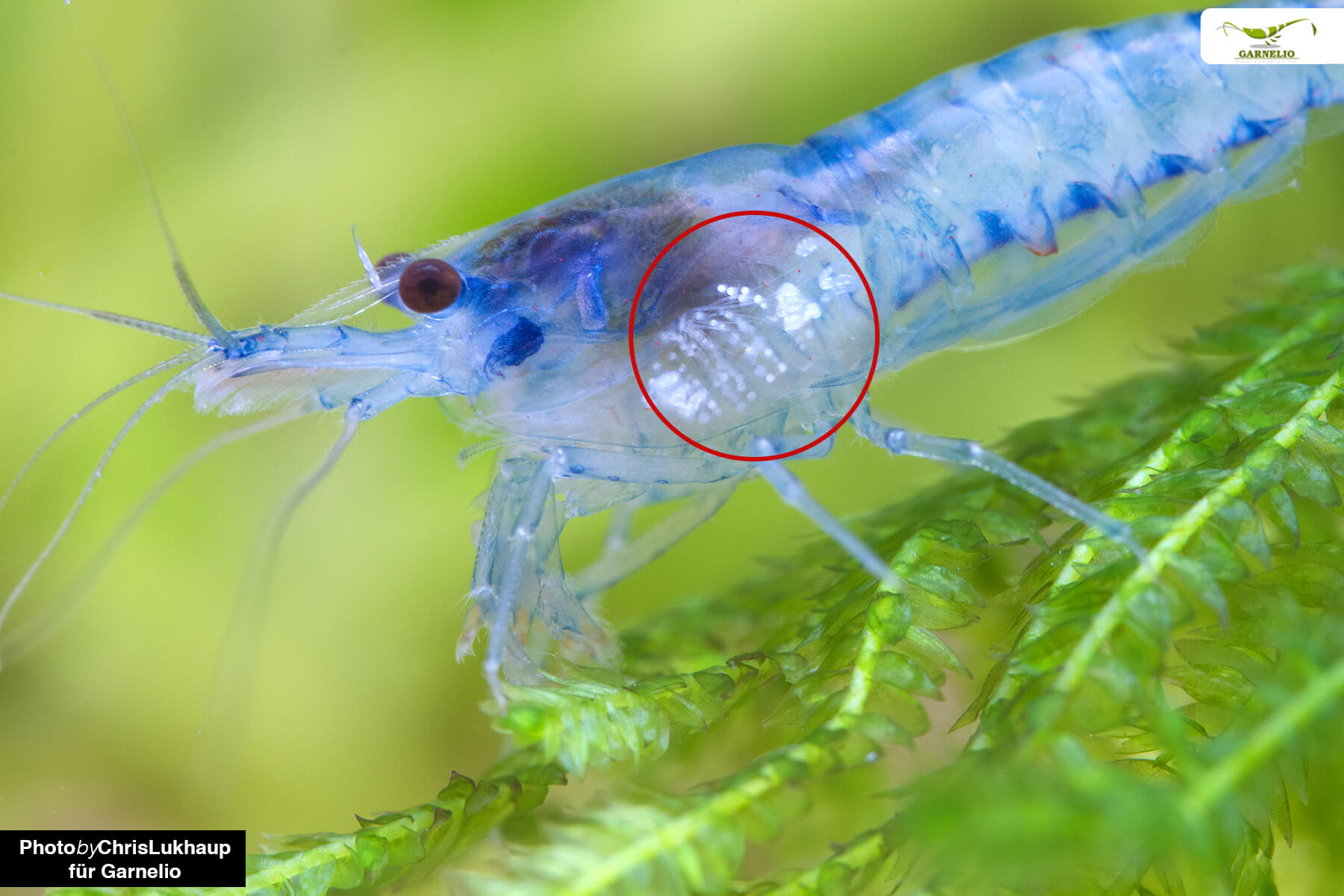
Is it necessary to control sucking worms, and if so, how?
Unfortunately, without a microscope it is impossible to tell for sure whether you are dealing with parasitic worms or not. To be on the safe side, most shrimp keepers therefore decide to prophylactically control the sucking worms on their Neocaridina.
Although veterinary worming products such as Panacur, Flubenol and preparations containing praziquantel or rafoxanide also help against sucking worms, improper use can promote resistance - not only in sucking worms, but also in many other worm species in the aquarium and in nature. In the hobby, a much safer method has become accepted, which we would like to present here.
Fighting sucking worms with a salt treatment
Normal table salt, i.e. sodium chloride, causes the sucking worms to let go of their host and fall to the ground stunned. The salt treatment against sucking worms can be carried out in the running aquarium, or individual infested shrimps can be specifically placed in a salt bath. The second approach is especially recommended if you have fish in the shrimp aquarium that do not tolerate table salt well, such as catfish - or if you have plants in the aquarium that are not salt tolerant.
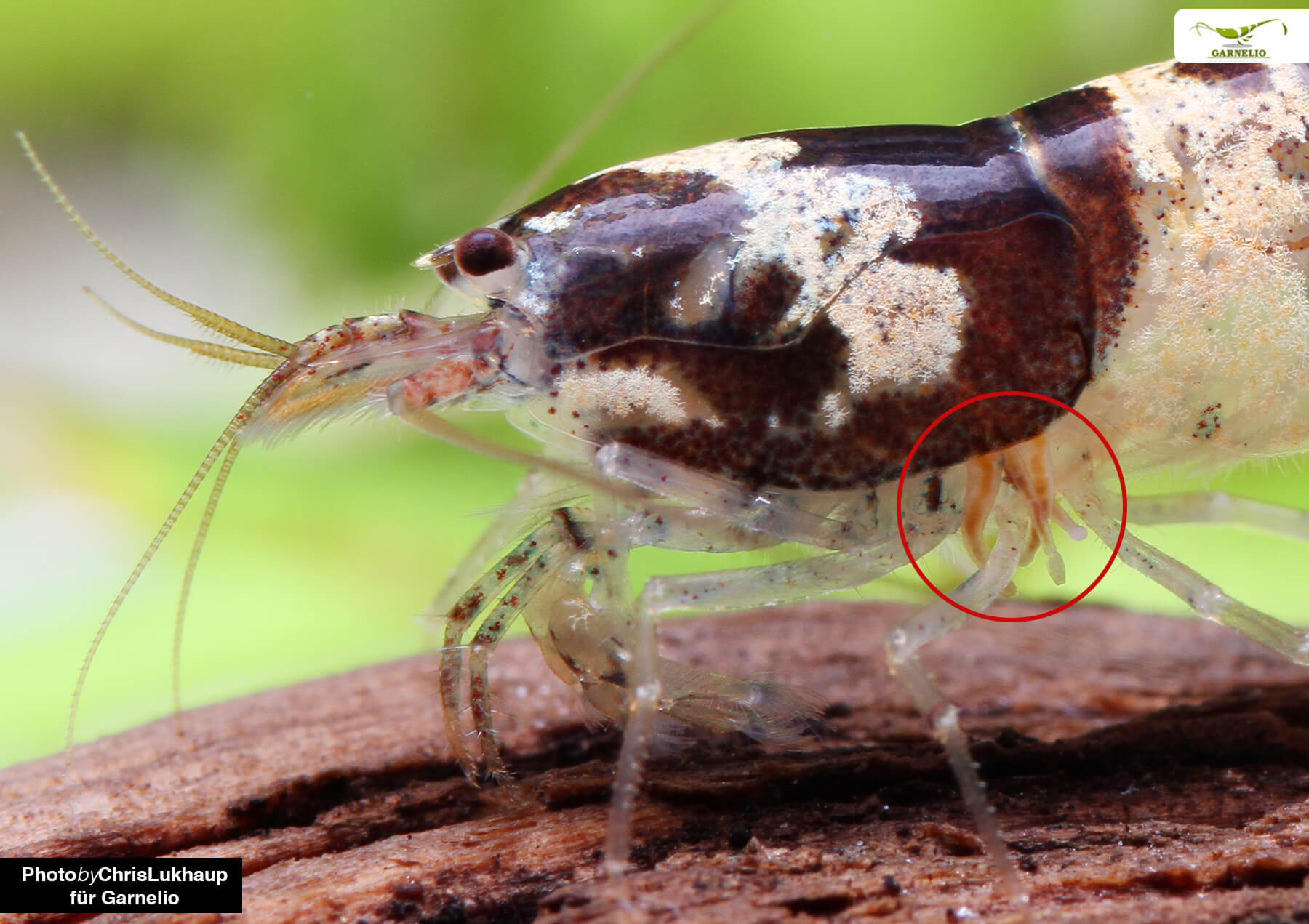
In the aquarium
In the aquarium, salt treatment against sucking worms in Neocaridina shrimp is done with pure table salt (sodium chloride, NaCl) - we never use iodized salt, nor iodized salt with flour or folic acid, nor sea salt, nor table salt with trickle. Dishwasher salt has proven effective in many cases because it is usually pure evaporated salt. 3-5 g of common salt are dosed per liter of aquarium content. The amount of salt is added to the aquarium. If you have soft water, you give 3 grams, in hard water you can go to the upper limit of 5 grams. Increasing the temperature in the aquarium to about 25-28 °C has proven to be helpful during the salt treatment. Bite place a bubbling stone or an oxydator in the aquarium to provide additional oxygen during the treatment!
The salt can remain in the aquarium until no more sucking worms are visible. When changing the water, add salt accordingly.
When the salt treatment is finished and the worms have disappeared, simply do not add any more salt after the water change, so that the amount of salt in the aquarium is gradually reduced.
If the inhabitants in the aquarium show by unusual behavior that there are problems during the salt treatment, one must immediately make a very large water change. In this case, of course, no new salt is added.
Salt bath
If not many shrimp have sucking worms or if fish or aquatic plants are kept in the aquarium that do not tolerate salt, a salt bath for the infested shrimp is an alternative. To do this, put in an extra container one liter of water from the aquarium where the shrimp live. Then stir 2 teaspoons of pure table salt (for example dishwasher salt) into soft water and 3 teaspoons into hard water and wait until the sodium chloride has completely dissolved. Put all the shrimp infested with sucking worms into this salt bath and leave them in the salt water for about 10 to 20 minutes. Please keep your shrimp under constant observation during the treatment. If they show problems such as staggering, falling over or try to flee the tank, please stop the treatment immediately and put them back into the aquarium. In the salt bath, the sucker worms let go and remain on the bottom of the vessel. You will see the fallen worms less well in light-colored vessels than on a dark bottom.
The salt bath should be performed again after a week so that young sucking worms that have hatched from the eggs in the meantime are also caught.
Additional measures to support salt treatment
As stated above, suckworms are actually weakling parasites. Therefore, in the event of an infestation, treatments should always be supported to prevent the worms from returning. Stress avoidance and stress reduction for the shrimp should be at the top of the list. The animals need rest, and constant redecorating and redesigning can put a lot of strain and stress on them. Also, permanent population control is not helpful - it is quite normal that shrimps hide and that you do not always see all of them. Under no circumstances should you constantly rummage around in the aquarium to see if all shrimp are still there. A high bacteria count in the water can also severely stress dwarf shrimp and put a strain on their immune system. Regular water changes with adapted water, vacuuming of the substrate and sensible, not too abundant feeding with a high-quality shrimp food can work wonders here. Humic substances also play an important role in whether shrimps feel comfortable in the aquarium - they can reduce germ density, support shrimp molting and make the water overall biotope-friendly. Sufficient oxygen through an oxydator or a bubbling stone can also be crucial in reducing stress. All in all, all these measures are useful for keeping shrimp healthy in the aquarium anyway - the fact that they can also support and help with a sucker worm infestation is an added bonus.
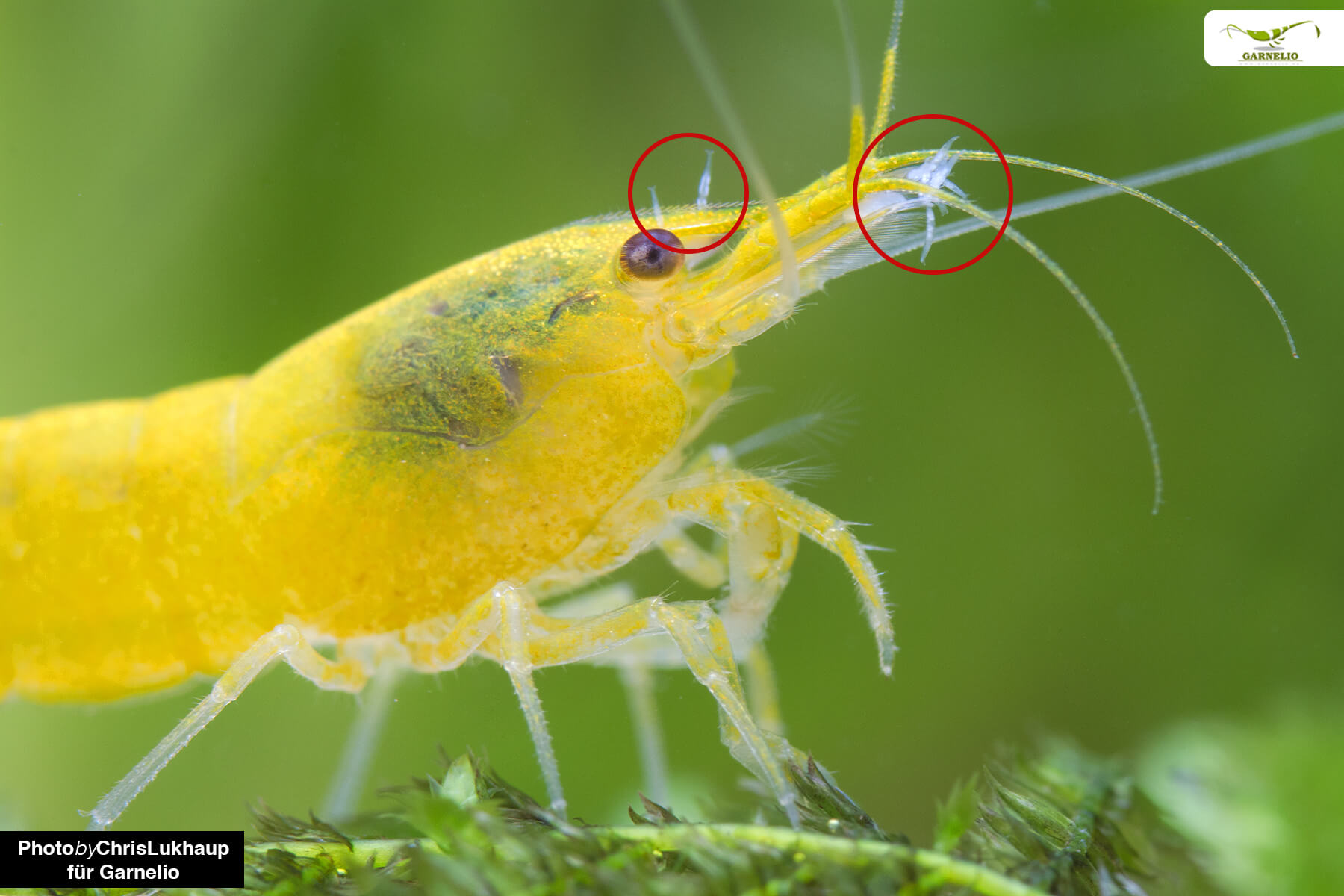

Hat so gut geholfen!
Ich wollte keine Chemie ins Aquarium kippen und das Salzbad hat super gewirkt. Sie sind sofort abgefallen. Man darf auf keinen Fall vergessen es nach 1 Woche zu wiederholen (was ich beim ersten Mal hatte) - sonst sind sie wieder da, da die Eier geschlüpft sind. Ich kann diese Methode sehr empfehlen. Als Salz verwende ich Spülmaschinensalz (da reines NaCl und ohne Rieselhilfe).
Danke
Danke für den Tipp. Habe diese Salz-Therapie gemacht und kann sagen, dass die Saugwürmer tatsächlich abfallen und es den Garnelen gut geht. Leider kommen die Saugwürmer immer wieder, aber nun weiß ich ja was zu tun ist.